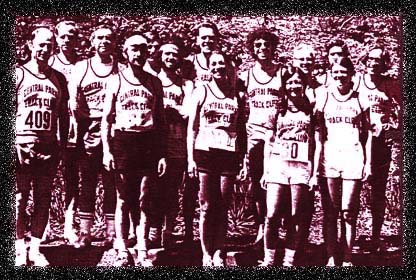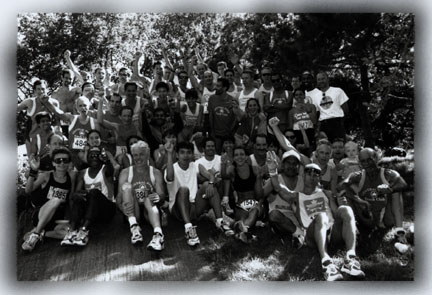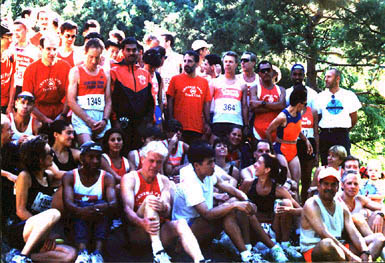|
Central Park Track
Club
Then and Now

CENTRAL PARK TRACK CLUB 1972

CENTRAL PARK TRACK CLUB 1996
ANALYSIS
What can we infer from these photographs? In the first
photograph, we observe the rigidity of the postures and body orientations
and the obvious spacing between people. By constrast, the second
photograph is total chaos. Without knowing anything else, an objective
observer would guess that the 1972 club is more serious (and successful)
about personal and competitive achievements in running, but the
1996 club has no sense of discipline and is more fun to be with.
True?
Reference:
Edward T. Hall (1966) Handbook of Proxemic Research.
Washington DC: Society for the Anthropology of Visual Communication.
REACTION POSTED 2/25/97
The obvious lack of regard for personal space in
the 1996 photograph (dominated by a half-nekkid Karel Matousek)
demonstrates quite effectively what level of adultery is currently
running rampant in our ranks. An objective observer would rightly
guess that the 1972 club is more serious - never mind that the club
seems to have been founded by hippies-turned-lawyers (i.e., in the
guise of Handelman Blackstone & Partners). Observations
gathered at the recent Snowflake Party (2/22/97) back up claims
by outsiders (representatives from MILL, NYH, NYF, MCNY, etc. were
present in force) that CPTC is just way too touchy-feely to be considered
anything more than a drunken dry-land hot tub. Is, has been,and
always will be.
--Anonimus
AMEN
(Webmaster: This piece was published as submitted.
I am not responsible for any spelling errors)
REACTION POSTED ON 3/1/97
How do you know that some runner is from the Central Park Track
Club? Through the club uniform. According to the American
Heritage Dictionary, 'uniform' means 'always the same;
conforming to one prinicple, standard, or rule; consistent; unvaried
in texture, color or design.' The 1972 club is uniformly dressed,
but everyone on the 1996 club seems to have his or her own outfit.
We need some major soul-searching here!!!
REACTION POSTED ON 5/27/97
Fans of running history should take note as to who is present in
the 1972 photograph. The woman in the middle is Kathrine Switzer,
the pioneer for women's distance running and famous for her clandestine
entry (as K. Switzer) into the Boston Marathon. The man to
her right (that is, the fourth person from the left in the picture)
is the late Fred Lebow, who was instrumental in popularizing
road running in the USA, especially through the New York City
Marathon.
Of course, for the aficionados, the real question is, "So
who are the other blokes?" And was Frank Handelman there?
If so, what did he look like back then?
CONTRIBUTION POSTED ON 7/4/97

This is a color photo of the 1996 Central Park Track Club
team. What do we see here? A bunch of unruly, disorderly kids suffering
from Attention Deficit Hyperactivity Disorder (ADHD)! Team? What
team?
Take a good look at this picture. Now you can appreciate why Coach
George has to holler whenever he addresses this mob. First,
he has to get people's attention. Then, he has to be heard above
the din of parallel conversations. He gets more respect from the
kids in his History class. SO, PEOPLE, LISTEN
UP NEXT TIME!!!
PROTEST NOTE POSTED 7/14/97
If you compare the two 1996 photos, you see that Karel Matousek
figured prominently in the foreground of the black-and-white photo,
but he is not there in the color photo! This is a gross violation
of his rights!
Response # 1: He has no rights.
Response # 2: Besides, you are very wrong about the facts
because Karel had changed positions. In the color photo, he is present
with a vacant stare in a blue headband and a white singlet on the
left hand edge of the photo. What do you think is going through
his mind at that moment?

|
